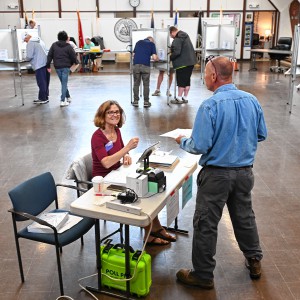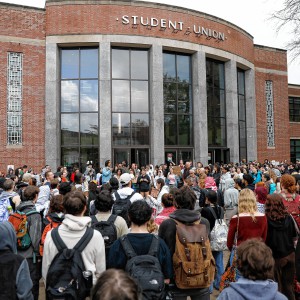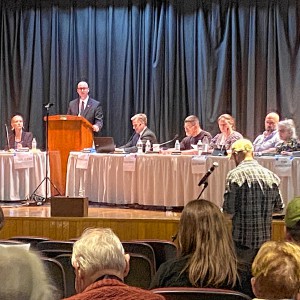First commercial carbon-sucking facility in U.S. opens in California
| Published: 11-12-2023 11:15 PM |
The U.S. is getting its first commercial facility to soak up carbon dioxide from the ambient air for permanent storage, a nascent technology that’s been both lauded as crucial in fighting climate change and derided as a distraction that will delay the clean energy transition.
The plant near San Francisco, built by Bay Area startup Heirloom Carbon Technologies, puts California at the forefront of the emerging carbon removal industry as a handful of so-called direct air capture (DAC) hubs are also slated to get underway. Heirloom’s facility, unveiled Thursday, will be capable of removing and storing as much as 1,000 tons of carbon dioxide each year.
That’s a pittance compared with bigger plants poised to come online in Texas and Louisiana, but it’s enough to serve as a milestone for a technology that’s likely to spawn a significant business. JPMorgan Chase & Co. and Google parent Alphabet Inc. are among the companies that have pledged hundreds of millions to buy carbon removal services, even as critics warn the industry will give oil producers an excuse to keep pumping crude.
Heirloom raised $53 million in a 2022 Series A round from investors including Microsoft’s Climate Innovation Fund and Bill Gates’ Breakthrough Energy Ventures. While Heirloom declined to disclose the price tag to build the California facility, the company aims to operate at a cost of $100 per ton of carbon removed by 2030 — a price point the young industry currently isn’t close to reaching.
The Biden administration is throwing its weight behind the technology, too. In August, the Department of Energy announced the first wave of projects that won some of the $3.5 billion in funding for developing DAC hubs around the U.S.
Though the Tracy facility is not a recipient of those dollars, Heirloom is part of one of those projects and its technology will be deployed at a major hub in Louisiana the government expects will remove 1 million tons of CO2 a year by the end of the decade. Heirloom and other DAC companies can also receive tax credits from the Inflation Reduction Act.
Research shows that gathering billions of tons of the greenhouse gas from the air each year by mid-century, in addition to rapid emissions reductions, will almost certainly be needed to limit global warming to 1.5C.
Carbon capture and removal is “positioned to play an important role in decarbonizing the U.S. economy,” according to BloombergNEF. The carbon market could reach $1 trillion by 2037 if rules prioritize high-quality removals, BNEF found in a separate analysis.
Article continues after...
Yesterday's Most Read Articles
 Political newcomer defeats Shores Ness for Deerfield Selectboard seat
Political newcomer defeats Shores Ness for Deerfield Selectboard seat
 South County Senior Center opts not to renew church lease after rift over LGBTQ program
South County Senior Center opts not to renew church lease after rift over LGBTQ program
 More than 130 arrested at pro-Palestinian protest at UMass
More than 130 arrested at pro-Palestinian protest at UMass
 As I See It: Between Israel and Palestine: Which side should we be on, and why?
As I See It: Between Israel and Palestine: Which side should we be on, and why?
 Moratoriums on large-scale solar, battery storage passed in Northfield
Moratoriums on large-scale solar, battery storage passed in Northfield
 Bridge of Flowers in Shelburne Falls to open on plant sale day, May 11
Bridge of Flowers in Shelburne Falls to open on plant sale day, May 11
DAC, which is still in its infancy, uses vacuum-like machines to pull CO2 out of the atmosphere and store it using a variety of methods. Heirloom’s facility will use an electric-powered kiln to heat crushed limestone, transforming it into a calcium-based paste that’s spread onto stacked trays that act as carbon-absorbing sponges. Once saturated with the CO2, the material returns to the kiln, where the carbon is removed before the process repeats. The Tracy plant will store CO2 in tanks, though Heirloom and other companies plan to inject it deep underground for future projects. The facility’s technology differs from a more controversial method called carbon capture, which involves removing CO2 emitted at the smokestack. That technology can help decarbonize heavy industry, but oil companies have deployed it to capture CO2 then inject it underground to help extract more fossil fuels.

 Speaking of Nature: Indulging in eye candy: Finally, after such a long wait, it’s beginning to look like spring is here
Speaking of Nature: Indulging in eye candy: Finally, after such a long wait, it’s beginning to look like spring is here Celebrating ‘Seasonings’: New book by veteran preacher and poet, Allen ‘Mick’ Comstock
Celebrating ‘Seasonings’: New book by veteran preacher and poet, Allen ‘Mick’ Comstock Faith Matters: How to still the muddy waters of overthinking: Clarity, peace and God can be found in the quiet spaces
Faith Matters: How to still the muddy waters of overthinking: Clarity, peace and God can be found in the quiet spaces A time for every purpose under heaven: Free sing-a-long Pete Seeger Fest returns to Ashfield, April 6
A time for every purpose under heaven: Free sing-a-long Pete Seeger Fest returns to Ashfield, April 6
